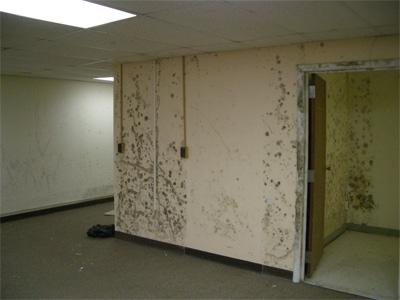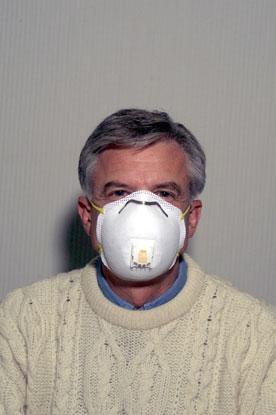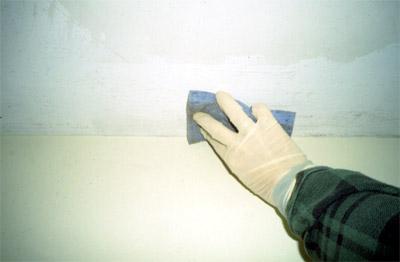Mold Course Chapter 4:
General Remediation Issues
Lesson 1 - Dry Quickly
To dry carpet and backing within 48 hours, remove water with a wet vacuum, pull the carpet and pad off the floor and dry them using a fan to blow air over them. A dehumidifier can be used to reduce the humidity in the room where the carpet and backing are drying, while fans can be used to accelerate the drying process.
Water can be removed from concrete or cinder block surfaces with a water-extraction vacuum. The drying also can be accelerated by using dehumidifiers, fans and heaters.
Hard surface flooring (such as linoleum, ceramic tile and vinyl) should be vacuumed or damp wiped with a mild detergent and allowed to dry. They should be scrubbed clean, if necessary. If the under-flooring is wet, it should be dried using a vacuum or by exposing it to the air.
Non-porous, hard surfaces such as plastics and metals should be vacuumed or damp wiped with water and mild detergent, then allowed to dry. Scrubbing may be necessary to thoroughly clean the surfaces.
Water should be removed from upholstered furniture with a water-extraction vacuum. Fans, dehumidifiers and heaters may be used to accelerate the drying process. Completely drying upholstered furniture within 48 hours may be difficult, so if the piece is valuable, you may consider consulting a restoration or water-damage professional who specializes in furniture.
Drywall, also known as gypsum board or gypsum wallboard, may be dried in place if there is no obvious swelling and the seams are intact. Otherwise, removal is necessary. The wall cavity is the most difficult area to dry, and it should be ventilated if drywall is left to dry in place. (Drywall is not made out of boards of wood; traditionally, drywall is made of the mineral gypsum with a layer of heavy paper on the outside and inside. Commercial gypsum boards and drywall are also available with a variety of outside layers and coatings. According to the U.S. Geological Survey, a typical new home contains more than 7 metric tons of gypsum.)
To clean water-damaged window drapes, follow the manufacturer's laundering or cleaning instructions.
To clean wooden surfaces, remove moisture immediately and use dehumidifiers, fans and gentle heat to dry them. (Be very careful when applying heat to hardwood floors.) Treated or finished wood surfaces can be cleaned with mild detergent and clean water, then allowed to dry. Wet paneling should be pried from the wall for drying.
Some water-damaged items that may have to be discarded include:
- Ceiling tiles
- Cellulose and fiberglass insulation
- Drywall and gypsum board
- Books and papers
If valuable or important books, documents, or other items are moldy or water damaged, you may wish to consult a restoration, water damage, or remediation expert. For more details see Table 1.
These guidelines are for damage caused by clean water. If you know or suspect that the water is contaminated with sewage, or with chemical or biological pollutants, then PPE and containment are required by OSHA. An experienced professional should be consulted if you or your remediators do not have expertise remediating in contaminated water situations. Do not use fans until you have determined that the water is clean or sanitary.
Lesson 2 - Assess Mold Problem
Before planning a remediation effort, the size and extent of the mold problem and any continuing moisture problems should be assessed. Remediations generally can be divided into small (less than 10 square feet of mold), medium (10-100 square feet of mold) and large jobs (more than 100 square feet of mold). A remediation manager should be selected for medium or large jobs. You may choose to involve an experienced health and safety professional in remediation projects, particularly on large or complex jobs.
Questions to consider before starting remediation include:
- Are there existing moisture problems in the building?
- Have building materials been wet more than 48 hours?
- Are there hidden sources of water, or is the humidity high enough to cause condensation?
- Are the building occupants reporting musty or moldy odors?
- Are the building occupants reporting health problems?
- Are building materials or furnishings visibly damaged?
- Has maintenance been delayed or has the maintenance plan been altered?
- Has the building been remodeled recently, or has its use changed?
- Are consultations with health professionals indicated?
Remediating mold and moisture problems may be complex, and it may increase workers' exposure to mold unless personal protective equipment (PPE) is used.
Avoid Mold Exposure
- Do not touch mold or moldy items with your bare hands.
- Do not get mold or mold spores in your eyes.
- Avoid breathing in mold or mold spores.
- Consider using PPE if disturbing mold during a building inspection, assessment, or walkthrough, for example. The minimum PPE is an N-95 respirator (available at most hardware stores), gloves and goggles
- Review guidelines for using containment and PPE before starting remediation. See Table 2.
Remediation workers, especially if they have health concerns, may want to check with their doctors before working on a mold investigation or remediation project. Anyone who has any doubts or questions should consult a healthcare professional before beginning work on a remediation project. For more information on PPE see Chapter 6.4.
Lesson 3 - Remediation Plan
The highest priority in a remediation is to protect the health and safety of the building occupants and the remediation workers. Remediation plans vary according to the size and complexity of the job. They may require updating if circumstances change or more extensive contamination is discovered.
The remediation plan should include:
- Whether containment will be required.
- What level of PPE will be used.
- How the water or moisture problem will be fixed so the mold problem does not recur.
- How the moldy building materials will be removed to avoid spreading mold.
Lesson 4 - Mold Remediation Procedures
A variety of methods are available to remediate damage to buildings and furnishings caused by moisture-control problems and mold. The procedures selected depend on the size of the moldy area and the type of contaminated materials. Budget may also be a concern. The methods presented in this section outline one approach; some professionals may prefer to use other methods. If possible, remediation activities should be scheduled during off-hours, when building occupants are less likely to be affected.
Cleanup methods
- Wet Vacuum
Wet, or water-extraction, vacuums are designed to collect water. They can be used to remove water that has accumulated on floors, carpets and hard surfaces. Wet vacuums should be used only when materials are still wet, otherwise they may spread mold spores. Wet vacuums alone will not dry carpets. Wet carpets must be pulled up and dried, then reinstalled. The carpet padding also must be dried. The tanks, hoses and attachments of wet vacuums should be thoroughly cleaned and dried after use because mold and mold spores may stick to their surfaces. - Damp Wipe
Mold can generally be removed from hard surfaces by wiping or scrubbing with water and detergent. Always follow the cleaning instructions on product labels. Surfaces cleaned by damp wiping should be dried quickly and thoroughly to discourage further mold growth. Porous materials that are wet and have mold growing on them may have to be discarded. Because mold will infiltrate porous substances and grow on or fill in empty spaces or crevices, completely removing mold can be difficult, if not impossible. Mold can also cause staining and other cosmetic damage. -
HEPA Vacuum
High-Efficiency Particulate Air (HEPA) vacuums are recommended for the final clean up of remediation areas after materials have been thoroughly dried and contaminated materials have been removed. HEPA vacuums are also recommended for cleaning up dust that has settled outside the remediation area. When changing the vacuum filter, workers should wear PPE to prevent exposure to mold that has been captured in the vacuum. (See Lesson 4 in Chapter 6 of this course.) The filter and contents of the HEPA vacuum must be disposed of in well-sealed plastic bags. Care must be taken to ensure that the new filter is properly seated on the vacuum so there are no leaks.
Throw Away Damaged Materials
Mold-contaminated building materials that cannot be salvaged should be double-bagged in 6-mil or thicker polyethylene bags. The bagged materials usually can be discarded as ordinary construction waste. Packaging mold-contaminated materials in sealed bags before removing them from the containment area is important to minimize the spread of mold spores throughout the building. Large items that have heavy mold growth should be covered with polyethylene sheeting and sealed with duct tape before being removed from the containment area.






